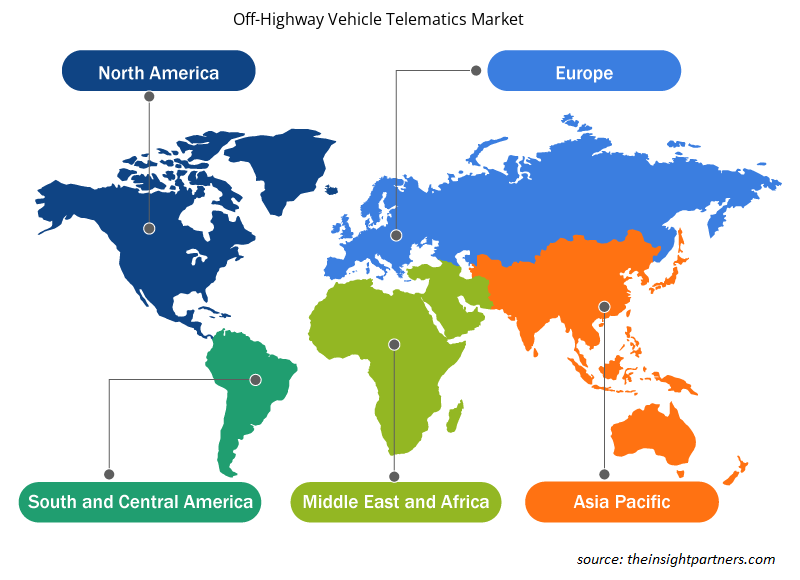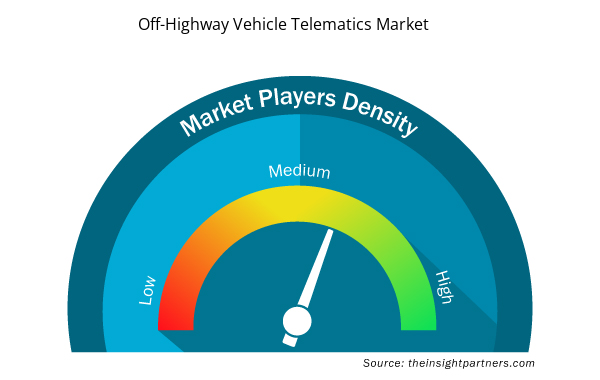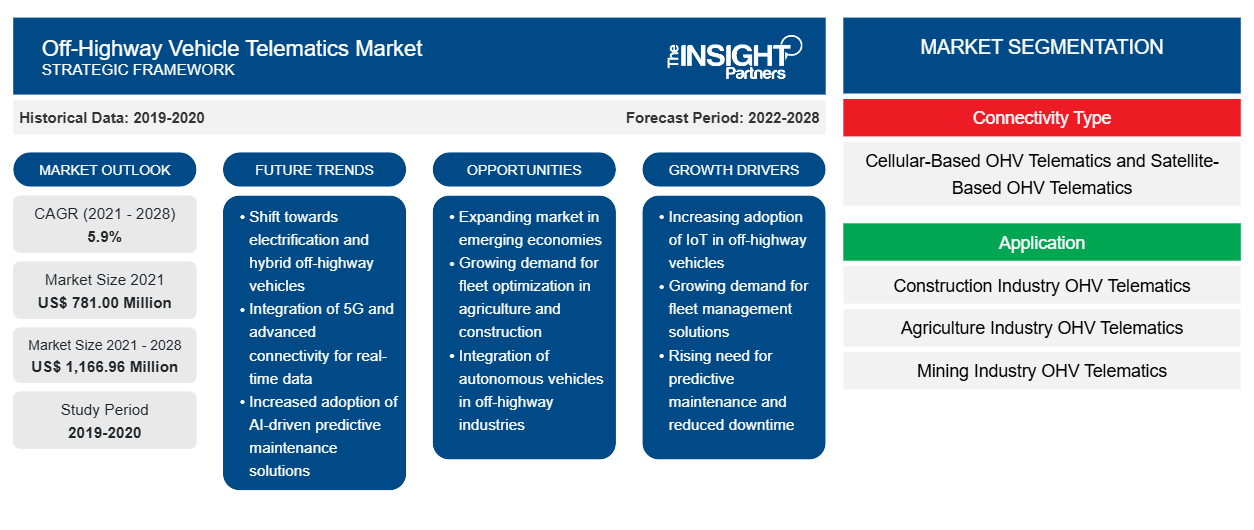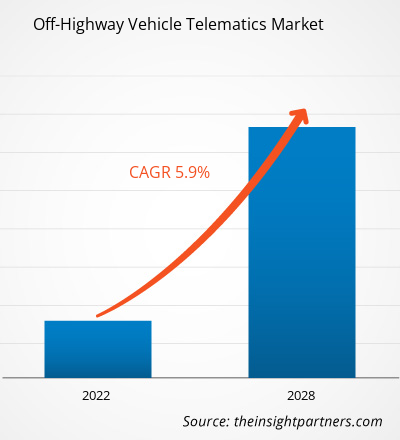Il mercato della telematica per veicoli fuoristrada è stato valutato a 781,00 milioni di dollari nel 2021 e si prevede che raggiungerà 1.166,96 milioni di dollari entro il 2028; si stima che registrerà un CAGR del 5,9% nel periodo di previsione dal 2021 al 2028.
Il business della telematica si è evoluto rapidamente grazie ai progressi nelle tecnologie. Alcune nuove tendenze all'orizzonte che devono essere analizzate per restare un passo avanti alla concorrenza sono:-
- Rete interconnessa rapida: l'aggiornamento alle reti 4G e 5G offre un'esperienza completamente nuova in termini di larghezza di banda, caricamento dati più rapido e download di feedback, con conseguenti set di dati in tempo reale, sicurezza dei conducenti in tempo reale, manutenzione della flotta ed efficienza della flotta.
- Abilitazione cloud: i sensori sono collegati a diversi sottosistemi in un veicolo. Questi sistemi scambiano costantemente enormi quantità di dati. I sensori per il monitoraggio della pressione degli pneumatici, l'acquisizione video e il monitoraggio della temperatura sono solo alcuni esempi. I progressi nella tecnologia cloud hanno reso possibile archiviare, gestire e utilizzare con successo enormi quantità di dati.
- Adozione da parte delle piccole imprese: la telematica è diventata più di una semplice tendenza per i fornitori di servizi e i proprietari di piccole flotte. Molte start-up forniscono soluzioni telematiche economiche ma efficaci che possono essere trovate sul mercato locale per i proprietari di piccole flotte.
- Accesso diretto ai dati e dashboard intuitive: gli utenti hanno accesso diretto ai dati per il processo decisionale. Singoli conducenti, responsabili delle spedizioni, un'agenzia centrale della flotta o un ufficio locale e franchisee traggono vantaggio da questi dati. A tutti gli stakeholder vengono fornite dashboard personalizzate basate sui ruoli con accesso limitato per prendere decisioni informate in tempo reale in base alle loro specifiche esigenze di servizio, orari di consegna o arrivo, vincoli di movimentazione e altri fattori. Ciò aiuta anche le aziende di gestione della flotta a mantenere una scheda di valutazione dei conducenti basata sul comportamento e ha implicazioni legali. Molte aziende scambiano anche dati con il settore delle spedizioni e dei trasporti per migliorare la pianificazione degli attracchi. Ciò aiuta nella pianificazione efficace e si traduce in conducenti più felici e produttivi.
Pertanto, i crescenti progressi tecnologici nella telematica dei veicoli fuoristrada guideranno la crescita del mercato della telematica dei veicoli fuoristrada.
Personalizza questo report in base alle tue esigenze
Riceverai la personalizzazione gratuita di qualsiasi report, comprese parti di questo report, o analisi a livello nazionale, pacchetto dati Excel, oltre a usufruire di grandi offerte e sconti per start-up e università
- Scopri le principali tendenze di mercato in questo rapporto.Questo campione GRATUITO includerà analisi di dati che spaziano dalle tendenze di mercato alle stime e alle previsioni.
La rapida trasformazione digitale del settore edile sollecita l'adozione di nuove tecnologie che offrono nuove prospettive per il mercato della telematica dei veicoli fuori strada. La telematica delle attrezzature edili aiuta le aziende a tracciare la posizione e le prestazioni delle proprie attrezzature, a monitorare l'utilizzo delle risorse e a verificare che le risorse vengano utilizzate in modo efficace. Se le attrezzature sono sottoutilizzate, potrebbero essere spostate in un'altra posizione in cui sono necessarie. Ecco come la telematica per le attrezzature edili migliora l'efficienza complessiva che, a sua volta, avrebbe un impatto positivo sul mercato della telematica fuori strada.
Inoltre, l'aumento dell'attività edilizia sia nel settore privato che in quello pubblico probabilmente potenzierà la crescita del mercato. Diversi progetti infrastrutturali sono in corso o pianificati in paesi come India, Filippine, Emirati Arabi Uniti, Arabia Saudita, Egitto, Nigeria e Stati Uniti. Ad esempio, il governo indiano ha stanziato un budget di 1,12 miliardi di dollari per l'attuale anno fiscale come parte del programma "Cento città intelligenti" nel bilancio dell'Unione del 2014-2015. Inoltre, il governo prevede di investire 650 miliardi di dollari in vari progetti urbani e infrastrutturali in tutto il paese nei prossimi 20 anni, il che, a sua volta, sosterrebbe la crescita del mercato della telematica per veicoli fuoristrada. Sono in corso vari progetti infrastrutturali in Medio Oriente, tra cui Jeddah Economic City (Arabia Saudita), Masdar City (Emirati Arabi Uniti) e Dubailand (Emirati Arabi Uniti). Questa rapida crescita dei progetti infrastrutturali probabilmente aumenterà la domanda di attrezzature edili.
Impatto della pandemia di COVID-19 sul mercato telematico dei veicoli fuoristrada del Nord America
Il Nord America è una delle regioni leader in termini di sviluppo e adozione di nuove tecnologie grazie a politiche governative favorevoli che stimolano l'innovazione e rafforzano le capacità infrastrutturali. Pertanto, qualsiasi impatto negativo sulla crescita del settore industriale ostacola la crescita economica della regione. Attualmente, gli Stati Uniti sono il paese più colpito al mondo a causa dell'epidemia di COVID-19. La dipendenza del mercato della telematica per veicoli fuoristrada dagli attori della produzione, come le aziende automobilistiche e i produttori di componenti per automobili, è stata evidenziata dalla recente pausa nelle unità di produzione a causa dell'epidemia di COVID-19. Anche prima dell'epidemia di COVID-19, il settore automobilistico ha dovuto affrontare sfide come la mobilità elettrica, le auto senza conducente, le fabbriche automatizzate e il car sharing . L'industria automobilistica sta subendo una battuta d'arresto importante a causa delle severe restrizioni sui viaggi, della chiusura della produzione internazionale, del calo delle vendite di auto e dei grandi licenziamenti. È probabile che la domanda complessiva di telematica per veicoli fuoristrada aumenti una volta che le industrie raggiungeranno normali condizioni operative. Grazie all'aumento della domanda di automobili, alle politiche governative favorevoli e ai sempre maggiori investimenti dei paesi nordamericani in tecnologie avanzate, il Nord America registra una forte domanda di telematica per veicoli fuoristrada.
Approfondimenti sul mercato della telematica per veicoli fuoristrada
Crescente integrazione dell'IoT
Sistemi microelettromeccanici, Internet e tecnologie wireless si sono uniti per formare l'Internet delle cose (IoT). I proprietari di flotte possono utilizzare l'IoT per monitorare da remoto la velocità del veicolo, la pressione dell'aria degli pneumatici, il consumo di carburante e il comportamento del conducente, migliorando ulteriormente l'efficienza del veicolo e del conducente. Gli sviluppatori di sistemi telematici possono utilizzare questa tecnologia per creare soluzioni telematiche su misura per esigenze specifiche nei settori minerario, agricolo ed edile, dove i costi operativi sono elevati. I fornitori di servizi e gli operatori di flotte possono adottare l'analisi predittiva combinando l'IoT e la tecnologia di gestione della flotta. Ciò fornisce il contesto per realizzare una gestione proattiva e un vantaggio competitivo in diverse aree operative critiche. I sensori IoT nei prodotti orientati al servizio, come i condizionatori d'aria, possono notificare una chiamata di servizio solo quando necessario, anziché a intervalli regolari. Il monitoraggio basato sulle condizioni riduce i costi di servizio aumentando al contempo la precisione e il servizio clienti. Una delle spese più significative per qualsiasi flotta è il carburante. Se i sensori IoT sono integrati nel sistema telematico, i gestori della flotta possono ottenere una visione quasi in tempo reale del consumo e delle spese di carburante del veicolo. Ciò consente ai manager di vedere chi deve essere istruito sui comportamenti di guida efficaci e di monitorare le spese operative e i modelli di guida illeciti, come il minimo, che può sprecare benzina. Inoltre, tutte le flotte pongono grande attenzione sulla sicurezza. Con l'aumento di incidenti di eccesso di velocità, frenate brusche e guida aggressiva, i gestori delle flotte possono utilizzare il coaching dei conducenti e l'educazione alla sicurezza per affrontare i comportamenti di guida indesiderati. Pertanto, la crescente integrazione dell'IoT può aprire nuove possibilità commerciali.
Approfondimenti di mercato basati sul tipo di connettività
In base al tipo di connettività, il mercato della telematica per veicoli fuoristrada è segmentato in telematica OHV basata su cellulare e telematica OHV basata su satellite. Il segmento della telematica OHV basata su cellulare ha guidato il mercato della telematica per veicoli fuoristrada con una quota del 77,6% nel 2020.
Approfondimenti di mercato basati sulle applicazioni
In base all'applicazione, il mercato della telematica per veicoli fuoristrada può essere segmentato in telematica OHV per l'industria edile, telematica OHV per l'industria agricola, telematica OHV per l'industria mineraria e altri. Il segmento della telematica OHV per l'industria edile ha guidato il mercato della telematica per veicoli fuoristrada con una quota del 64,3% nel 2020.
Approfondimenti regionali sul mercato della telematica per veicoli fuoristrada
Le tendenze regionali e i fattori che influenzano il mercato della telematica per veicoli fuoristrada durante il periodo di previsione sono stati ampiamente spiegati dagli analisti di Insight Partners. Questa sezione discute anche i segmenti e la geografia del mercato della telematica per veicoli fuoristrada in Nord America, Europa, Asia Pacifico, Medio Oriente e Africa, e America meridionale e centrale.

- Ottieni i dati specifici regionali per il mercato telematico dei veicoli fuoristrada
Ambito del rapporto sul mercato della telematica per veicoli fuoristrada
| Attributo del report | Dettagli |
|---|---|
| Dimensioni del mercato nel 2021 | 781,00 milioni di dollari USA |
| Dimensioni del mercato entro il 2028 | 1.166,96 milioni di dollari USA |
| CAGR globale (2021 - 2028) | 5,9% |
| Dati storici | 2019-2020 |
| Periodo di previsione | 2022-2028 |
| Segmenti coperti | Per tipo di connettività
|
| Regioni e Paesi coperti | America del Nord
|
| Leader di mercato e profili aziendali chiave |
|
Densità degli attori del mercato: comprendere il suo impatto sulle dinamiche aziendali
Il mercato della telematica per veicoli fuoristrada sta crescendo rapidamente, spinto dalla crescente domanda degli utenti finali dovuta a fattori quali l'evoluzione delle preferenze dei consumatori, i progressi tecnologici e una maggiore consapevolezza dei vantaggi del prodotto. Con l'aumento della domanda, le aziende stanno ampliando le loro offerte, innovando per soddisfare le esigenze dei consumatori e capitalizzando sulle tendenze emergenti, il che alimenta ulteriormente la crescita del mercato.
La densità degli operatori di mercato si riferisce alla distribuzione di aziende o società che operano in un particolare mercato o settore. Indica quanti concorrenti (operatori di mercato) sono presenti in un dato spazio di mercato in relazione alle sue dimensioni o al valore di mercato totale.
Le principali aziende che operano nel mercato della telematica per veicoli fuoristrada sono:
- Wacker Neuson SE
- Azienda
- TTControl GmbH
- Omnitracs, LLC
- Società a responsabilità limitata
Disclaimer : le aziende elencate sopra non sono classificate secondo un ordine particolare.

- Ottieni una panoramica dei principali attori del mercato telematico dei veicoli fuoristrada
Approfondimenti di mercato basati sulla tecnologia
In base alla tecnologia, il mercato della telematica per veicoli off-highway può essere segmentato in LTE-M, NB-IoT, Sigfox e altri. LTE-M ha guidato il mercato della telematica per veicoli off-highway con una quota dell'82,3% nel 2020.
Gli operatori che operano nel mercato della telematica per veicoli off-highway adottano strategie quali fusioni, acquisizioni e iniziative di mercato per mantenere le loro posizioni nel mercato. Di seguito sono elencati alcuni sviluppi da parte degli operatori chiave:
- Nel gennaio 2022, Stoneridge e Valens Semiconductor hanno stretto partnership per lo sviluppo di soluzioni di sicurezza per trattori e rimorchi tramite connettività avanzata e visione, che a loro volta avranno un impatto positivo sul mercato della telematica off-highway.
- Ad agosto 2020, la famiglia di controller HY-TTC 500 è stata certificata per l'uso su strada. HY-TTC 500 è composta da unità di controllo di sicurezza di fascia alta, progettate per creare un'architettura elettronica centralizzata e sicura. La certificazione del controller HY-TTC 500, un prodotto di TTControl, ottiene la certificazione per l'uso su strada secondo ISO 26262.
Profili aziendali
- Omnitracs, LLC
- ORBCOMM
- Azienda
- Teletrac Navman
- TomTom International BV
- Unità di tracciamento A/S
- Produttore Wacker Neuson
- Zonar Systems Inc.
- TTCONTROL GMBH
- Gruppo ACTIA
- Analisi storica (2 anni), anno base, previsione (7 anni) con CAGR
- Analisi PEST e SWOT
- Valore/volume delle dimensioni del mercato - Globale, regionale, nazionale
- Industria e panorama competitivo
- Set di dati Excel



Report Coverage
Revenue forecast, Company Analysis, Industry landscape, Growth factors, and Trends

Segment Covered
This text is related
to segments covered.

Regional Scope
North America, Europe, Asia Pacific, Middle East & Africa, South & Central America

Country Scope
This text is related
to country scope.
Domande frequenti
Based on connectivity type, the off-highway vehicle telematics market is segmented into Cellular-Based OHV telematics, and Satellite-Based OHV telematics. The cellular-Based OHV telematics segment led the off-highway vehicle telematics market with a share of 77.6% in 2020.
Growth in construction industry and government policies to increase security and safety of off-highway vehicles are driving the growth of the off-highway vehicle telematics market.
The market opportunity lies in developing countries. Developing countries have become a hub of opportunity for various markets, including off-highway vehicle telematics market. The growing integration of the IoT can open up new commercial possibilities thus are presenting significant potential for the future growth of the off-highway vehicle telematics market players.
In 2020, North America led the market with a substantial revenue share, followed by Asia Pacific and Europe. North America is a prospective market for off-highway vehicle telematics developers.
The major companies in off-highway vehicle telematics includes Omnitracs, LLC; ORBCOMM; Stoneridge, Inc.; Teletrac Navman; TomTom International BV; Trackunit A/S; Wacker Neuson, Zonar Systems Inc.; TTCONTROL GMBH; and ACTIA Group.
Based on application, the off-highway vehicle telematics market can be segmented Construction Industry OHV telematics, Agriculture Industry OHV telematics, Mining Industry OHV telematics, and Others. The construction industry OHV telematics segment led the Off-Highway Vehicle Telematics market with a share of 64.3% in 2020.
Trends and growth analysis reports related to Automotive and Transportation : READ MORE..
The List of Companies - Off-Highway Vehicle Telematics Market
- Wacker Neuson SE
- Stoneridge, Inc.
- TTControl GmbH
- Omnitracs, LLC
- ORBCOMM Inc.
- Trackunit A/S
- TomTom Telematics BV
- Zonar Systems Inc.
- Teletrac Navman
- ACTIA Group
The Insight Partners performs research in 4 major stages: Data Collection & Secondary Research, Primary Research, Data Analysis and Data Triangulation & Final Review.
- Data Collection and Secondary Research:
As a market research and consulting firm operating from a decade, we have published and advised several client across the globe. First step for any study will start with an assessment of currently available data and insights from existing reports. Further, historical and current market information is collected from Investor Presentations, Annual Reports, SEC Filings, etc., and other information related to company’s performance and market positioning are gathered from Paid Databases (Factiva, Hoovers, and Reuters) and various other publications available in public domain.
Several associations trade associates, technical forums, institutes, societies and organization are accessed to gain technical as well as market related insights through their publications such as research papers, blogs and press releases related to the studies are referred to get cues about the market. Further, white papers, journals, magazines, and other news articles published in last 3 years are scrutinized and analyzed to understand the current market trends.
- Primary Research:
The primarily interview analysis comprise of data obtained from industry participants interview and answers to survey questions gathered by in-house primary team.
For primary research, interviews are conducted with industry experts/CEOs/Marketing Managers/VPs/Subject Matter Experts from both demand and supply side to get a 360-degree view of the market. The primary team conducts several interviews based on the complexity of the markets to understand the various market trends and dynamics which makes research more credible and precise.
A typical research interview fulfils the following functions:
- Provides first-hand information on the market size, market trends, growth trends, competitive landscape, and outlook
- Validates and strengthens in-house secondary research findings
- Develops the analysis team’s expertise and market understanding
Primary research involves email interactions and telephone interviews for each market, category, segment, and sub-segment across geographies. The participants who typically take part in such a process include, but are not limited to:
- Industry participants: VPs, business development managers, market intelligence managers and national sales managers
- Outside experts: Valuation experts, research analysts and key opinion leaders specializing in the electronics and semiconductor industry.
Below is the breakup of our primary respondents by company, designation, and region:

Once we receive the confirmation from primary research sources or primary respondents, we finalize the base year market estimation and forecast the data as per the macroeconomic and microeconomic factors assessed during data collection.
- Data Analysis:
Once data is validated through both secondary as well as primary respondents, we finalize the market estimations by hypothesis formulation and factor analysis at regional and country level.
- Macro-Economic Factor Analysis:
We analyse macroeconomic indicators such the gross domestic product (GDP), increase in the demand for goods and services across industries, technological advancement, regional economic growth, governmental policies, the influence of COVID-19, PEST analysis, and other aspects. This analysis aids in setting benchmarks for various nations/regions and approximating market splits. Additionally, the general trend of the aforementioned components aid in determining the market's development possibilities.
- Country Level Data:
Various factors that are especially aligned to the country are taken into account to determine the market size for a certain area and country, including the presence of vendors, such as headquarters and offices, the country's GDP, demand patterns, and industry growth. To comprehend the market dynamics for the nation, a number of growth variables, inhibitors, application areas, and current market trends are researched. The aforementioned elements aid in determining the country's overall market's growth potential.
- Company Profile:
The “Table of Contents” is formulated by listing and analyzing more than 25 - 30 companies operating in the market ecosystem across geographies. However, we profile only 10 companies as a standard practice in our syndicate reports. These 10 companies comprise leading, emerging, and regional players. Nonetheless, our analysis is not restricted to the 10 listed companies, we also analyze other companies present in the market to develop a holistic view and understand the prevailing trends. The “Company Profiles” section in the report covers key facts, business description, products & services, financial information, SWOT analysis, and key developments. The financial information presented is extracted from the annual reports and official documents of the publicly listed companies. Upon collecting the information for the sections of respective companies, we verify them via various primary sources and then compile the data in respective company profiles. The company level information helps us in deriving the base number as well as in forecasting the market size.
- Developing Base Number:
Aggregation of sales statistics (2020-2022) and macro-economic factor, and other secondary and primary research insights are utilized to arrive at base number and related market shares for 2022. The data gaps are identified in this step and relevant market data is analyzed, collected from paid primary interviews or databases. On finalizing the base year market size, forecasts are developed on the basis of macro-economic, industry and market growth factors and company level analysis.
- Data Triangulation and Final Review:
The market findings and base year market size calculations are validated from supply as well as demand side. Demand side validations are based on macro-economic factor analysis and benchmarks for respective regions and countries. In case of supply side validations, revenues of major companies are estimated (in case not available) based on industry benchmark, approximate number of employees, product portfolio, and primary interviews revenues are gathered. Further revenue from target product/service segment is assessed to avoid overshooting of market statistics. In case of heavy deviations between supply and demand side values, all thes steps are repeated to achieve synchronization.
We follow an iterative model, wherein we share our research findings with Subject Matter Experts (SME’s) and Key Opinion Leaders (KOLs) until consensus view of the market is not formulated – this model negates any drastic deviation in the opinions of experts. Only validated and universally acceptable research findings are quoted in our reports.
We have important check points that we use to validate our research findings – which we call – data triangulation, where we validate the information, we generate from secondary sources with primary interviews and then we re-validate with our internal data bases and Subject matter experts. This comprehensive model enables us to deliver high quality, reliable data in shortest possible time.


 Ottieni un campione gratuito per questo repot
Ottieni un campione gratuito per questo repot